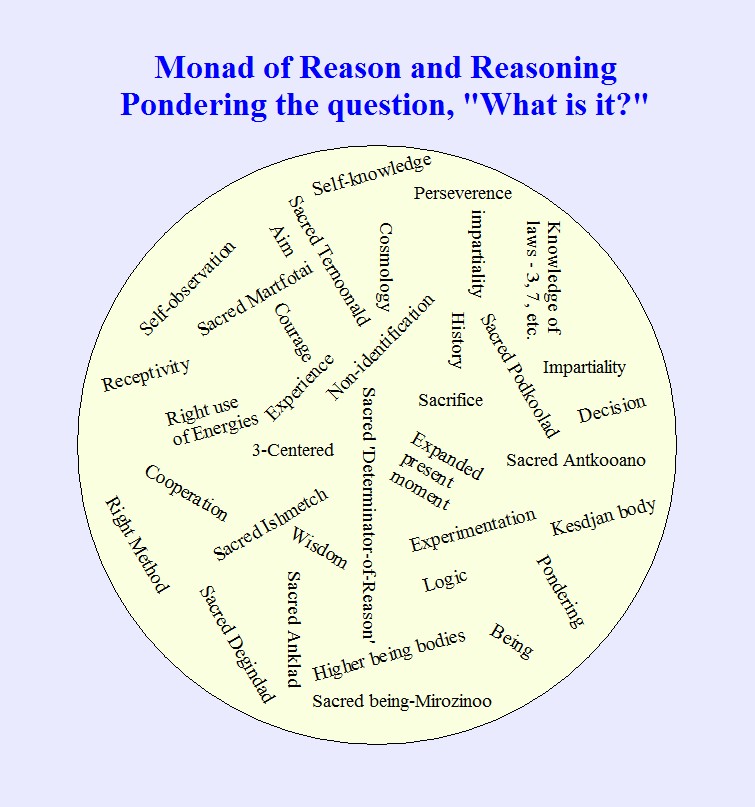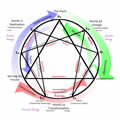Monad of Reasoning
2015-02-15
As I was once again pondering the question, “What is Reason and Reasoning?” I found myself mentally constructing a monad. A monad, for those who haven’t studied Systematics is one of several methods for examining objects, processes, relationships, or any other type of complex system. The “methods” of monad, dyad, triad, tetrad, pentad, and so on, refer to the number of independent terms that are used (allowed) for that particular system. So in constructing a monad only one type of “term” or element is allowed.
One of the disciplines of the monad is to refuse to give any element more significance than any other element. Consequently, all elements have equal standing, hence the unordered appearance of the monad as shown below. The individual elements might be regarded as being holographic representations of the whole with the entire monad demonstrating “unity in diversity”.
Quoting from J. G. Bennett’s “The Dramatic Universe”…
The monad is an undifferentiated diversity. We meet this state of affairs whenever we turn our attention to a new situation, large or small. The monadic character of the universe as a totality, is present in all its parts. Every such part appears in its immediacy as an undifferentiated totality of which we know nothing except that it is what it is. But, side by side with this bare knowledge, we are led on, by the conviction that it is a structure, to hope to understand it by examining its content more closely. This combination of confused immediacy and the expectation of finding an organized structure gives the monad a progressive character. It is what it is, but it holds promise of being more than it appears to be.
This starting point is very important for the development of understanding. We shall call it the act of identifying the monad. The act requires both cognition and judgment, that is Fact and Value, and so takes us into the Domain of Harmony. We do not yet know anything clearly, but we can select a particular region out of the totality to be our field of study, understanding and action. If the region is primarily composed of mental images associated with words, we call it a 'universe of discourse'. If it is a class of objects, we call it a 'population'. If it is a complex of energies, we call it a 'field'. If it is a situation requiring action, we call it a 'problem'. Common to all of these descriptive names is the property of challenging our capacity for understanding."
More information on the monad and Systematics in general can be found on the Systematics.org website.
Back to the monad of Reason and Reasoning… The terms shown below represent a first approximation in response to pondering the question “What is Reasoning?” As such, it’s not so much an answer as a jumping off point. In fact it probably raises more questions than it answers. But as Bennett indicated, it holds the promise of greater understanding if we persevere. To ponder the monad is an important and quite significant form of Reasoning, with its own methods and disciplines as alluded to above.

- John Hutcherson's blog
- Log in to post comments

Comments
Seeking order in chaos
John, I’m wondering how we might be able to make this somewhat more grounded. What seems awkward in this exploration of reasoning is a number of distracting clues. The word ‘reasoning’ has a very strong connotation of logical or rational thinking, but it seems clear that what we are tracking goes far beyond logic or rationality, particularly if it’s outcome nourishes higher being-bodies. Otherwise it would only be necessary to strengthen our ordinary logical thinking. Perhaps an expression like ‘growing steadily toward objective reason’ might point in a more practical direction. This might make more sense of the ‘word cloud’ you developed within the Monad diagram from the perspective of applying the ideas practically.
Another distracting clue is that, of the many terms within the Monad, all/some/none/something else, could apply as the cause or the effect of ‘reasoning’ or perhaps reflexively, both. Or not. It’s as if (either) reason(ing) is a switchboard with all these cables coming out to their specific labels – but the connecting plug ends have all been pulled out and tossed in a pile. Or alternatively, all those cables are plugged into something even higher up but the ones that plug into ‘reasoning’ have been unplugged and mixed in with all the other loose ends as well. So, it’s beginning to look a lot like everything.... or nothing... or something else. We might be on the right track, or not. And how will we know? What criteria can we use to know?
If it is not to become too intellectually theoretical and detached from real life, the connection of reasoning to the aim of the Work we’re doing in group certainly needs to be more clear for me. Or, more briefly, I’m lost in all this... I reason.